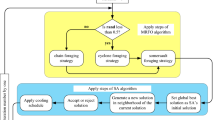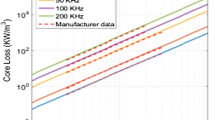Abstract
This paper addresses a novel multi-objective fruit fly optimization algorithm (MOFOA) for solving multi-objective optimization problems. The essence of MOFOA lies in its having two characteristic features. For the first feature, a population of random fruit flies initializes the algorithm. During this initialization phase, the dominated fruit fly is replaced by the nearest non-dominated one. Subsequently, the fruit flies undergo evolution by flying randomly around the non-dominated solution or around the reference point, i.e., the best location of the individual objectives. Afterwards, the fruit flies are updated according to the nearest location whether from the reference point or the previous non-dominated location. For the second feature, the weighted sum method is incorporated to update the previous best locations of fruit flies and the reference point to emphasize the convergence of the non-dominated solutions. To prove the capability of the proposed MOFOA, two standard benchmark problems in addition to the real world application, namely, multi-objective shape design of tubular linear synchronous motor (TLSM) are checked. The corresponding TLSM objective functions aims to maximize operating force and to minimize the flux saturation. The outcomes clearly demonstrate the effectiveness of the proposed algorithm for finding the non-dominated solutions.














Similar content being viewed by others
Abbreviations
- \(\mathbf{x}\) :
-
Decision variable vector
- \(F(\mathbf{x})\) :
-
Objective function vector
- \(g_i (\mathbf{x})\) :
-
\(i\hbox {th}\) inequality constraint
- \(h_j (\mathbf{x})\) :
-
\(j\hbox {th}\) equality constraint
- \(f_k (\mathbf{x})\) :
-
\(k\hbox {th}\) element of objective function vector
- \(x_i^{L}\) :
-
Lower bound vector on the \( i\hbox {th}\) decision variable
- \(x_i^{U}\) :
-
Upper bound on the \( i\hbox {th}\) decision variable
- \(\Omega ,{\Omega }'\) :
-
Feasible regions
- \({\mathbb R}\) :
-
Set of real numbers
- \({\mathbb R}^{n}\) :
-
Set of n-dimensional real vectors
- K :
-
Number of objective functions
- m :
-
Number of inequality constraints
- N :
-
Number of equality constraints
- n :
-
Number of decision variables
- \(\succ \) :
-
Worse than
- \(k_{\mathrm{fill}}\) :
-
Fill factor
- i :
-
Current in the conductor
- ns :
-
Number of conductors
- ins :
-
Slot current
- \(\tau _p\) :
-
Pole pitch
- p :
-
Number of poles
- B :
-
Flux density
- l :
-
Length of magnetic pole
- \(h_{s} \) :
-
The height of the slot
- \(h_{m} \) :
-
Height of the magnet
- \(t_{s} \) :
-
Slot thickness
- rand():
-
Random number generator between 0 and 1
- PS:
-
The population size of fruit flies
- E, A :
-
Repositories to store the non-dominated solutions
- RP :
-
Repository to store the value of best variable corresponding to the individual objective
- R :
-
Search radius
- \(\Delta (t,R)\) :
-
Step function returns a value in the range [0, R]
- T :
-
Maximum number of iterations
References
Yuan X et al (2014) On a novel multi-swarm fruit fly optimization algorithm and its application. Appl Math Comput 233:260–271
Mousa AA, El-Wahed Waiel F, Abd Rizk-Allah RM (2011) A hybrid ant colony optimization approach based local search scheme for multiobjective design optimizations. Electr Power Syst Res 81(4):1014–1023
Coello CA (2000) An updated survey of GA-based multiobjective optimization techniques. ACM Comput Surv (CSUR) 32(2):109–143
Coello CAC, Van Veldhuizen DA, Lamont GB (2002) Evolutionary algorithms for solving multi-objective problems, vol 242. Kluwer Academic, New York
Deb K (2001) Multi-objective optimization using evolutionary algorithms, vol 16. Wiley, New York
Coello CAC, Pulido GT, Lechuga MS (2004) Handling multiple objectives with particle swarm optimization. IEEE Trans Evolut Comput 8(3):256–279
Li X, Du G (2013) BSTBGA: a hybrid genetic algorithm for constrained multi-objective optimization problems. Comput Oper Res 40(1):282–302
El-Sehiemy RA, Abd-Elwanis MI, Kotb AB, Elwany M (2010) Synchronous motor design using particle swarm optimization technique. In: Proceedings of the 14th International Middle East Power Systems Conference (MEPCON’10), Cairo University, Egypt, December 19–21, pp 795–800
Rizk-Allah RM (2014) A novel multi-ant colony optimization for multi-objective resource allocation problems. Int J Math Arch 5(9):183–192
El-Sawy AA, Zaki EM, Rizk-Allah RM (2012) A novel hybrid ant colony optimization and firefly algorithm for solving constrained engineering design problems. J Nat Sci Math 6(1):1–22
Shaheen AM, El Sehiemy R, Farrag S (2015) Optimal reactive power planning using integrated versions differential evolution optimizer. In: Recent trends in energy systems conference RTES’2015, Benha University, pp 279–288, October 2015
Shaheen AM, El-Sehiemy RA, Farrag SM (2015) Adequate planning of shunt power capacitors involving transformer capacity release benefit, pp 1–10. doi:10.1109/JSYST.2015.2491966
Shaheen AM, El-Sehiemy RA, Farrag SM (2015) Reactive power planning using multi-objective differential evolution. In: Proceedings of the 17th International Middle East Power Systems Conference (MEPCON’15), Mansoura University, Egypt, December 15–17, 2015, Paper #1001
Shaheen AM, El-Sehiemy RA, Farrag SM (2015) Allocation of reactive power resources using multi-objective differential evolution algorithm. In: Proceeding of Recent Advances in Electrical Engineering and Computer Science Conference, Michigan State University, USA, Sept 20–22, pp 134–142
Shaheen AM, El-Sehiemy RA, Farrag SM (2016) Solving multi-objective optimal power flow problem via forced initialised differential evolution algorithm. IET Gener Transm Distrib 10(7):1634–1647
Shaheen AM, El-Sehiemy RA, Farrag SM (2016) A novel adequate bi-level reactive power planning strategy. Int J Electr Power Energy Syst 78:897–909
Sakr W, El-Sehiemy RA, Azmy AR (2015) Optimizing reactive power dispatch considering TCSC allocation by modified differential evolution algorithm. In: Proceedings of the 17th International Middle East Power Systems Conference (MEPCON’15), Mansoura University, Egypt, December 15–17, 2015, Paper # 1023
Yang X-S, Deb S, Fong S (2014) Bat algorithm is better than intermittent search strategy. J Multi-Valued Log Soft Comput 22(3):223–237
Ranjan Srivastava P, Chis M, Deb S, Yang X-S (2012) An efficient optimization algorithm for structural software testing. Int J Artif Intell 8(12):68–77
Yang X-S, Deb S, Karamangolu M, He X (2012) Cuckoo search for business optimization applications. In: Proceedings of NCCCS2012, IEEE, pp 29–33. doi:10.1109/NCCCS.2012.6412973
Yang X-S, Deb S, Loomes M, Karamanoglu M (2013) A framework for self-tuning optimization algorithm. Neural Comput Appl 23(7):2051–2057. doi:10.1007/s00521-013-1498-4
Wang G-G, Deb S, Cui Z (2015) Monarch butterfly optimization. Neural Comput Appl. doi:10.1007/s00521-015-1923-y
Wang G-G, Deb S, dos Santos Coelho L (2015) Earthworm optimization algorithm: a bio-inspired metaheuristic algorithm for global optimization problems. Int J Bio-Inspir Comput (2015) (in press)
Wang G-G, Deb S, Gao X-Z, dos Santos Coelho L (2016) A new metaheuristic optimization algorithm motivated by elephant herding behavior. Int J Bio-Inspir Computat (in press)
Fong S, Deb S, Yang X-S (2015) A heuristic optimization method inspired by wolf preying behavior. Neural Comput Appl 26(7):1725–1738
Askarzadeh A (2016) A novel metaheuristic method for solving constrained engineering optimization problems: crow search algorithm. Comput Struct 169:1–12
Yang X-S, Deb S, Fong S (2014) Metaheuristic algorithms: optimal balance of intensification and diversification. Appl Math Inf Sci 8(3):977–983
Pan W-T (2012) A new fruit fly optimization algorithm: taking the financial distress model as an example. Knowl Based Syst 26:69–74
Li H, Guo S, Li C, Sun J (2013) A hybrid annual power load forecasting model based on generalized regression neural network with fruit fly optimization algorithm. Knowl Based Syst 37:378–387
Lin S-M (2013) Analysis of service satisfaction in web auction logistics service using a combination of fruit fly optimization algorithm and general regression neural network. Neural Comput Appl 22(3–4):783–791
Han J, Wang P, Yang X (2012) Tuning of PID controller based on fruit fly optimization algorithm. In: 2012 International Conference on Mechatronics and Automation (ICMA). IEEE, pp 409–413
Li C, Xu S, Li W, Hu L (2012) A novel modified fly optimization algorithm for designing the self-tuning proportional integral derivative controller. J Converg Inf Technol 7(16):69–77
Mousavi SM, Alikar N, Niaki STA (2015) An improved fruit fly optimization algorithm to solve the homogeneous fuzzy series—parallel redundancy allocation problem under discount strategies. Soft Comput, pp 1–27. doi:10.1007/s00500-015-1641-5
Jayashree HV et al (2016) Ancilla-input and garbage-output optimized design of a reversible quantum integer multiplier. J Supercomput 72(4):1477–1493
Baccarelli E et al (2016) Energy-efficient dynamic traffic offloading and reconfiguration of networked data centers for big data stream mobile computing: review, challenges, and a case study. IEEE Netw 30(2):54–61
Hama T, Sato K (2015) High-speed and high-precision tracking control of ultrahigh-acceleration moving-permanent-magnet linear synchronous motor. Precis Eng 40:151–159
Song H et al (2012) Combined constrained code and LDPC code for long-haul fiber-optic communication systems. In: Proceedings of IEEE Global Communications Conference (GLOBECOM), Anaheim, CA, Dec 3–7, pp 2984–2989
Miettinen K (2012) Nonlinear multiobjective optimization, vol 12. Springer Science & Business Media, Berlin
Deshpande AD (2002) A study of methods to identify constraint dominance in engineering design problems. Diss. University of Massachusetts, Amherst
Gieras JF, Piech ZJ, Tomczuk B (2011) Linear synchronous motors: transportation and automation systems. CRC Press, Boca Raton
Deshpande AD, Rinderle JR (2001) Linear electric drive for UMM. Technical Report, Department of Mechanical and Industrial Engineering, University of Massachusetts, Amherst
Author information
Authors and Affiliations
Corresponding author
Rights and permissions
About this article
Cite this article
Rizk-Allah, R.M., El-Sehiemy, R.A., Deb, S. et al. A novel fruit fly framework for multi-objective shape design of tubular linear synchronous motor. J Supercomput 73, 1235–1256 (2017). https://doi.org/10.1007/s11227-016-1806-8
Published:
Issue Date:
DOI: https://doi.org/10.1007/s11227-016-1806-8




